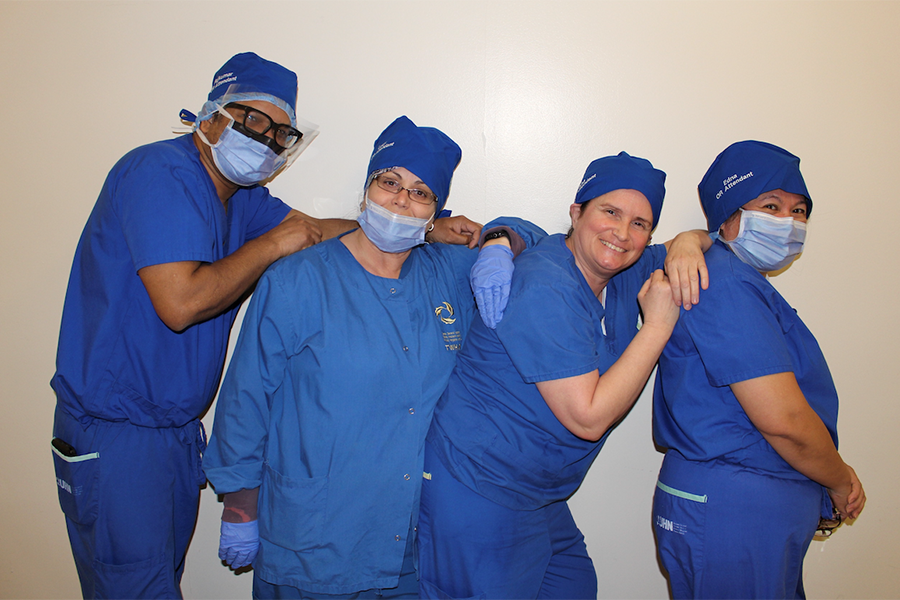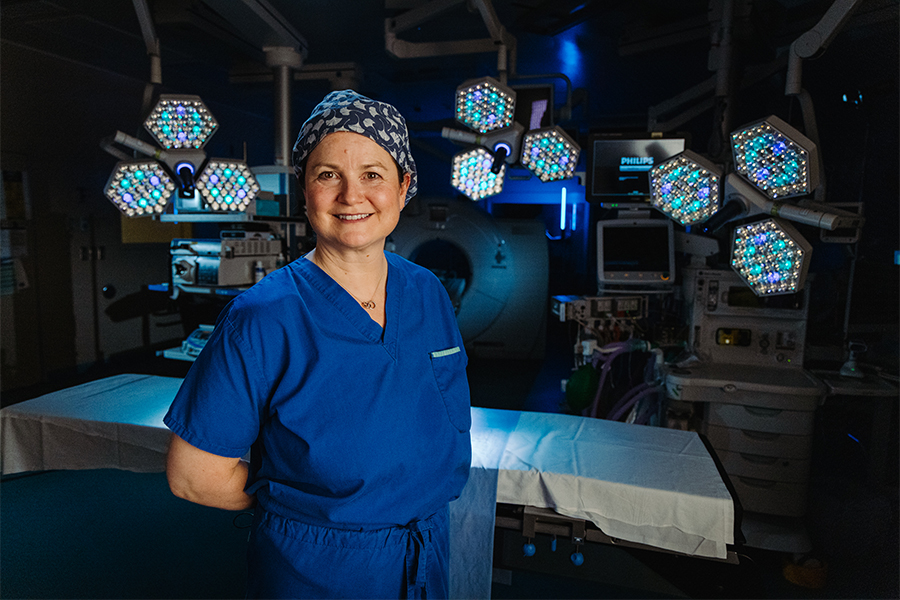Dr. Taufik Valiante is helping to develop revolutionary brain-related technologies at CRANIA. (Photo: Regina Garcia)
By Diane Peters
There aren’t many clinicians who can say they’re creating cutting-edge innovations, improving surgical outcomes and dramatically enhancing people’s lives. But that’s exactly what Dr. Taufik Valiante does every day. As the Co-Director of University Health Network’s (UHN’s) CRANIA, which stands for CentRe for Advancing Neurotechnological Innovation to Application, he and his team are creating a variety of highly advanced tools and technologies that will make it easier for surgeons to treat brain-related diseases.
One such innovation is the Neural Interface Processor for Brain-state Classification and Programmable-waveform Neurostimulation (NURIP), an epilepsy treatment device co-developed with Prof. Roman Genov of the Edward S. Rogers Sr. Department of Electrical & Computer Engineering at the University of Toronto. Computer chips implanted in the brain can detect a seizure as it’s about to happen and then deliver stimulation to stop it. The system leverages artificial intelligence to learn when and where in the brain a patient’s seizures tend to begin, in order to predict and prevent them.
“This is an exciting technology,” says Dr. Valiante, who is a neurosurgeon in the Sprott Department of Surgery and Director of the Surgical Epilepsy Program at the Krembil Brain Institute at UHN. “It allows us to personalize implanted devices based on an individual’s brain recordings. This means we can accurately detect when seizures are about to start and stimulate at an optimal time point to maximize the treatment efficacy. By avoiding false detections, the device can operate with a long battery life and minimize side effects.”
Dr. Valiante received the Connaught Innovation Award to kick-start NerveX Neurotechnologies, a company that will accelerate the clinical deployment of these machine-learning personalized implants for epilepsy treatment.
4,000,000
Source: CRANIA
Number of Canadians living with a neurological condition or injury.
Researchers at CRANIA are also interested in creating collagen-based electrodes and other innovative circuits, sensors and components for a variety of neuromodulation devices – tech that uses electrical stimulation on the brain and other parts of the body to alter nerve activity to treat Parkinson’s disease, epilepsy, Alzheimer’s and depression, among other conditions. “Surgeons have always been end users of new technology like this,” says Dr. Valiante. “I want to be on the forefront of developing new ones.”
A new way of working
One of the key benefits to CRANIA, which is housed in a 1,500-square-foot laboratory on the 14th floor of Toronto Western Hospital, is that it brings together researchers and surgeons with engineers, computer scientists and manufacturers. Thanks to this interdisciplinary approach, which can involve scientists from across various departments, Dr. Valiante and his team can learn about, and then target, problems that they wouldn’t have thought about on their own. They also work with clinicians to adapt existing technologies to treat other diseases and develop innovations that will ultimately make surgeries more efficient and effective.
To that end, there are plans to build a neuromodulation suite inside CRANIA to act as a high-tech operating room. The space, which will be ready in 2022, will allow surgeons to use new devices and finesse surgical approaches. It will have, among other features, a state-of-the-art magnetic resonance imaging (MRI) machine and an industrial magnet never applied in health care before. “This suite consolidates all kinds of surgical and medical equipment, such as robots, MRIs and neuronavigation to help simplify workflow,” he says. “It makes operations easier for surgeons and the anesthesia teams.”
A better way to build
CRANIA’s origins date back 13 years, when Dr. Milos Popovic, CRANIA’s Co-Director and Director and senior scientist at KITE Research Institute at Toronto Rehab, which is also part of UHN, had an idea to create an interdisciplinary research group focused on developing neuromodulation devices that could both improve patient outcomes and make surgeries easier to do. He secured funding from the Canada Foundation for Innovation (CFI) but it failed to attract a matching grant from the province. There was another problem: while he had some neurosurgery partners on board, they weren’t as committed to the project as he would have liked. Things started coming together when a colleague at UHN connected Dr. Valiante, who also had an idea to create a CRANIA-like lab, and Dr. Popovic. “We immediately developed a great relationship,” recalls Dr. Valiante, who admires Dr. Popovic’s big-picture thinking and positivity. For his part, Dr. Popovic says Dr. Valiante “has a lot of skills that your typical neurosurgeon does not have,” including understanding engineering and computer science. The trust between them spurred the project forward, he says.
In 2017, the two received $20 million from CFI and the Ontario government and philanthropic gifts through UHN Foundation to launch CRANIA. While the Centre develops devices and surgical techniques in-house, it also seeks collaborations from industry. “It becomes one-stop shopping,” explains Dr. Popovic. “If you’re a company, you can find us and come work with us.”
Projects will be further propelled forward by PhD and postdoctoral fellows registered with the CRANIA Neuromodulation Institute. “Our vision is to train the next generation of researchers and surgeons on novel devices, but also to train them for jobs in industry and government,” says Dr. Valiante. But the ultimate goal is getting products to market – which means into clinics and operating rooms to treat patients. “When you have surgeons and clinicians who really look at outcomes,” he says, “you can make a significant difference in the lives of patients.”


